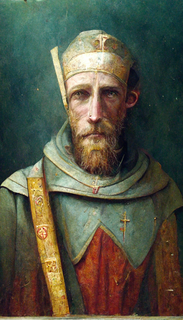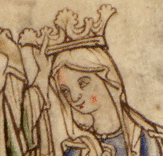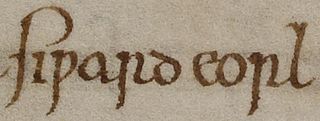
Ealdred was Abbot of Tavistock, Bishop of Worcester, and Archbishop of York in early medieval England. He was related to a number of other ecclesiastics of the period. After becoming a monk at the monastery at Winchester, he was appointed Abbot of Tavistock Abbey in around 1027. In 1046 he was named to the Bishopric of Worcester. Ealdred, besides his episcopal duties, served Edward the Confessor, the King of England, as a diplomat and as a military leader. He worked to bring one of the king's relatives, Edward the Exile, back to England from Hungary to secure an heir for the childless king.

William I, usually known as William the Conqueror and sometimes William the Bastard, was the first Norman king of England, reigning from 1066 until his death in 1087. A descendant of Rollo, he was Duke of Normandy from 1035 onward. By 1060, following a long struggle to establish his throne, his hold on Normandy was secure. In 1066, following the death of Edward the Confessor, William invaded England, leading an army of Normans to victory over the Anglo-Saxon forces of Harold Godwinson at the Battle of Hastings, and suppressed subsequent English revolts in what has become known as the Norman Conquest. The rest of his life was marked by struggles to consolidate his hold over England and his continental lands, and by difficulties with his eldest son, Robert Curthose.

Edward the Confessor was one of the last Anglo-Saxon English kings. Usually considered the last king of the House of Wessex, he ruled from 1042 to 1066.
Tostig Godwinson was an Anglo-Saxon Earl of Northumbria and brother of King Harold Godwinson. After being exiled by his brother, Tostig supported the Norwegian king Harald Hardrada's invasion of England, and was killed alongside Hardrada at the Battle of Stamford Bridge in 1066.
Lyfing of Winchester was an Anglo-Saxon prelate who served as Bishop of Worcester, Bishop of Crediton and Bishop of Cornwall.

Stigand was an Anglo-Saxon churchman in pre-Norman Conquest England who became Archbishop of Canterbury. His birth date is unknown, but by 1020 he was serving as a royal chaplain and advisor. He was named Bishop of Elmham in 1043, and was later Bishop of Winchester and Archbishop of Canterbury. Stigand was an advisor to several members of the Anglo-Saxon and Norman English royal dynasties, serving six successive kings. Excommunicated by several popes for his pluralism in holding the two sees, or bishoprics, of Winchester and Canterbury concurrently, he was finally deposed in 1070, and his estates and personal wealth were confiscated by William the Conqueror. Stigand was imprisoned at Winchester, where he died without regaining his liberty.
Waltheof, Earl of Northumbria was the last of the Anglo-Saxon earls and the only English aristocrat to be executed during the reign of William I.

Wulfstan was Bishop of Worcester from 1062 to 1095. He was the last surviving pre-Conquest bishop. Wulfstan is a saint in the Western Christian churches.

Edith of Wessex was Queen of England from her marriage to Edward the Confessor in 1045 until Edward died in 1066. Unlike most English queens in the 10th and 11th centuries, she was crowned. The principal source on her life is a work she herself commissioned, the Vita Ædwardi Regis or the Life of King Edward who rests at Westminster, which is inevitably biased.

Siward or Sigurd was an important earl of 11th-century northern England. The Old Norse nickname Digri and its Latin translation Grossus are given to him by near-contemporary texts. It is possible Siward may have been of Scandinavian or Anglo-Scandinavian origin, perhaps a relative of Earl Ulf, although this is speculative and unclear. He emerged as a powerful regional strongman in England during the reign of Cnut. Cnut was a Scandinavian ruler who conquered England in the 1010s, and Siward was one of the many Scandinavians who came to England in the aftermath of that conquest. Siward subsequently rose to become sub-ruler of most of northern England. From 1033 at the latest Siward was in control of southern Northumbria, that is, present-day Yorkshire, governing as earl on Cnut's behalf.

Thomas of Bayeux was Archbishop of York from 1070 until 1100. He was educated at Liège and became a royal chaplain to Duke William of Normandy, who later became King William I of England. After the Norman Conquest, the king nominated Thomas to succeed Ealdred as Archbishop of York. After Thomas' election, Lanfranc, Archbishop of Canterbury, demanded an oath from Thomas to obey him and any future Archbishops of Canterbury; this was part of Lanfranc's claim that Canterbury was the primary bishopric, and its holder the head of the English Church. Thomas countered that York had never made such an oath. As a result, Lanfranc refused to consecrate him. The King eventually persuaded Thomas to submit, but Thomas and Lanfranc continued to clash over ecclesiastical issues, including the primacy of Canterbury, which dioceses belonged to the province of York, and the question of how York's obedience to Canterbury would be expressed.

Gisa was Bishop of Wells from 1060 to 1088. A native of Lorraine, Gisa came to England as a chaplain to King Edward the Confessor. After his appointment to Wells, he travelled to Rome rather than be consecrated by Stigand, the Archbishop of Canterbury. As bishop, Gisa added buildings to his cathedral, introduced new saints to his diocese, and instituted the office of archdeacon in his diocese. After the Norman Conquest, Gisa took part in the consecration of Lanfranc, the new Archbishop of Canterbury, and attended Lanfranc's church councils. His tomb in Wells Cathedral was opened in the 20th century and a cross was discovered in his tomb.
Eadsige, was Archbishop of Canterbury from 1038 to 1050. He crowned Edward the Confessor as king of England in 1043.

Cynesige was a medieval English Archbishop of York between 1051 and 1060. Prior to his appointment to York, he was a royal clerk and perhaps a monk at Peterborough. As archbishop, he built and adorned his cathedral as well as other churches, and was active in consecrating bishops. After his death in 1060, the bequests he had made to a monastery were confiscated by the queen.
Earl of Northumbria was a title in the late Anglo-Saxon, Anglo-Scandinavian and early Anglo-Norman period in England. The earldom of Northumbria was the successor of the earldom of Bamburgh. In the seventh century, the Anglo-Saxon kingdoms of Bernicia and Deira were united in the kingdom of Northumbria, but this was destroyed by the Vikings in 867. Southern Northumbria, the former Deira, then became the Viking kingdom of York, while English earls ruled the former northern kingdom of Bernicia from their base at Bamburgh. The northern part of Bernicia was lost to the Scots, probably in the late tenth century. In 1006 Uhtred the Bold was earl of Bamburgh, and Æthelred the Unready appointed him earl of York as well, re-uniting the area of Northumbria still under English control into a single earldom. Uhtred was murdered in 1016, and Cnut then appointed Eric of Hlathir earl of Northumbria at York, but Uhtred's dynasty held onto Bernicia until 1041, when the earldom was again united. A descendant of Uhtred, Gospatric, was appointed earl by William the Conqueror in 1067, but William expelled him in 1072. Gospatric was then given lands in Scotland, and his descendants became earls of Dunbar. Northumbria was divided again along the Tees in the early Norman period and dissolved into the earldoms of York and Northumberland, with the latter including numerous autonomous liberties such as the County Palatine of Durham and Liberty of Tynedale.
Walter of Lorraine was a medieval Bishop of Hereford.
Events from the 1060s in England.
The House of Godwin was an Anglo-Saxon family and one of the leading noble families in England during the last 50 years before the Norman Conquest. Its most famous member was Harold Godwinson, king of England for nine months in 1066.
Eadulf Rus was an 11th-century Northumbrian noble, and the first recorded 'of Swinton'. He was either the son or grandson of Gospatric, possibly the man who soon after Christmas 1064 was allegedly killed on behalf of Tostig, Earl of Northumbria. This murder by Tostig led to a great northern revolt against Edward the Confessor, a revolt that turned both King Edward and Harold Godwinson against Tostig and led to the appointment of the Mercian, Morcar, as Earl of northern England.
Urse d'Abetot was a Norman who followed King William I to England, and became Sheriff of Worcestershire and a royal official under him and Kings William II and Henry I. He was a native of Normandy and moved to England shortly after the Norman Conquest of England in 1066, and was appointed sheriff in about 1069. Little is known of his family in Normandy, who were not prominent, but he probably got his name from the village Abetot. Although Urse's lord in Normandy was present at the Battle of Hastings, there is no evidence that Urse took part in the invasion of England in 1066.









